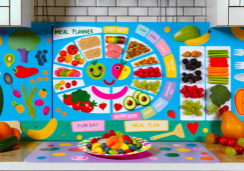4 Best Secrets to Budget-Friendly Family Meal Plans
You've discovered a culinary treasure map that leads to a land where your wallet is as full as your stomach.
As a guardian of your household's budget and palate, you've likely faced the Herculean task of balancing nutritious, delectable meals against the constraints of your bank account. Yet the secrets to triumphing in this daily challenge are simpler than you might think.
You're already one step ahead, knowing that planning, smart shopping, and creativity are your trusty allies. But how do you harness these tools to consistently deliver meals that delight without draining resources?
Stay tuned, as we're about to unveil the four cardinal strategies that will transform your meal planning from a dreaded chore into an effortless routine that saves money without skimping on taste or nutrition.
Prioritize Sales and Discounts
To maximize your food budget, always scout for sales and discounts at your local grocery stores before planning your family's meals. By aligning meal planning with the local grocery stores' weekly sales, you can eat healthy while managing costs.
Plan ahead and sift through the grocery flyers, letting the promotions guide your menu for the week. This approach not only saves money but also introduces a variety of nutrients into your family's diet, as you'll likely incorporate a range of seasonal produce and proteins that are being featured at a lower price.
You'll save time and stick to your financial plan by clipping digital coupons found on your grocery store's website or app. These savings by clipping digital coupons can be significant, and the convenience of having them on your phone means you'll never leave them behind. Consider store brands for further discounts; they're often comparable in quality to name brands.
Getting your children involved in this process can make meal planning more exciting for them. They'll learn the value of money and the importance of nutrition as they help choose items that are cost-effective and healthful.
Embrace Bulk Purchasing
Buying in bulk, items such as rice, wheat, and beans are a cost-effective strategy to stretch your family's meal budget further. Embracing bulk purchasing isn't just about saving money; it's also about planning ahead of time for multiple meals and ensuring you have the necessary pantry staples on hand. When you buy larger quantities, you're often rewarded with significant savings compared to the cost of smaller packages.
Here's how you can effectively incorporate bulk purchasing into your family meal plans:
- Legumes: Buy them in bulk and freeze in portion sizes. This way, you'll always have them ready for a nutritious addition to meals.
- Baked Goods: Try making your own bread or snacks from bulk-purchased wheat. It's budget-friendly and allows you to control the ingredients for healthier options.
- Yogurt: Opt for larger tubs instead of individual servings to enjoy savings and reduce packaging waste.
- Lunch Alternatives: Get creative and limit expensive lunchmeats by using bulk-purchased items to make hearty, nutritious lunches.
While grocery shopping, remember that bulk purchasing can greatly reduce your expenses and contribute to a balanced, nutrient-focused diet. With a little creativity and planning, you can make the most of your budget-friendly meal plans.
Incorporate Meatless Days
Building on the foundation of bulk purchasing, incorporating meatless days into your family's meal plan can further optimize your budget while embracing plant-based nutrition. By choosing meals centered around affordable plant-based proteins such as lentils and black beans, you're not only creating budget-friendly options but also diversifying the nutrients your family consumes. These pantry staples are cost-effective and can be bought in bulk, aligning perfectly with your grocery list strategies.
Consider establishing theme nights like Meatless Monday, which can simplify your meal planning process and ensure you stick to your budget. These regular, meat-free days encourage you to explore a variety of recipes that are both nutritious and wallet-friendly. Plus, committing to meatless days reduces decision fatigue, making it easier for you to prepare homemade meals that your family will love to eat.
When you do cook, make a little extra. Stretching leftovers into lunches or transforming them into a new dinner is a smart way to save money and keep your meal plans exciting.
Always remember to check weekly grocery deals to inform your meal planning. This approach ensures you're building a budget-friendly menu that's both satisfying and sustainable for your family's needs.
What are the best tips for budget-friendly family meal planning?
When it comes to budget-friendly family meal planning, there are a few tips that can help you save money without sacrificing nutrition or taste. First, try to plan your meals in advance, making a list of ingredients you need and sticking to it. Buying in bulk and opting for inexpensive yet nutritious staples like legumes and grains can also help stretch your budget. Additionally, consider incorporating more vegetarian options into your meal lineup, as plant-based proteins tend to be cheaper than meat. Lastly, don’t forget to embrace leftovers and repurpose them creatively to minimize food waste and maximize your budgetfriendly family meal planning efforts.
Master the Art of Leftovers
Mastering the art of leftovers not only reduces food waste but also stretches your food budget, as repurposing meals ensures every ingredient serves multiple purposes. You can breathe new life into your family's dining experience by turning leftovers into creative new dishes. Here's how to make the most out of your meals:
- Plan meals ahead of time with ingredients that can do double duty. For example, roast a chicken for one dinner and use the leftovers to create new dishes like tacos or a hearty soup.
- Get creative with a recipe called 'Anything Goes.' Gather any veggies, proteins, and grains you have left from the week and toss them into a stir-fry, frittata, or casserole.
- Turn one meal into another meal by repurposing sides. Last night's roasted vegetables can become today's vibrant salad topper or a colorful addition to a make homemade meals-style pizza.
- Embrace meal prep by cooking components that can be easily transformed. Cooked quinoa, for instance, can be a side dish one night and a base for a grain bowl the next.
Frequently Asked Questions
How Can I Feed My Family Healthy on a Budget?
You'll save money by meal prepping, buying in bulk, and shopping seasonally at local markets. Embrace plant-based proteins, clip coupons, and practice portion control. Start a kitchen garden and consider community-supported agriculture for savings.
How Do I Make a Budget-Friendly Meal Plan?
To make a budget-friendly meal plan, prep in advance and opt for ingredient swaps. Shop seasonally, buy in bulk, and rely on pantry staples. Reinvent leftovers, buy store brands, and use garden herbs.
How Do You Feed a Family of 4 on $10 a Day?
You'll feed a family of 4 on $10 by bulk buying, using coupons, and choosing inexpensive proteins. Opt for meatless meals, embrace seasonal eating, and shop at discount stores for the best value.
How Can I Feed My Family for $75 a Week?
You can feed your family for $75 a week by embracing meal themes, shopping seasonally, and visiting discount stores. Bulk cook, hunt for coupons, start a garden, and get creative with leftovers.
Conclusion
In conclusion, you've got the power to whip up budget-friendly meals without sacrificing nutrition or flavor. Keep an eye on those sales, embrace bulk buying for staples, mix in meatless days to cut costs, and turn leftovers into tomorrow's tasty triumphs.
By weaving together these savvy strategies, you're not only feeding your family well but also nurturing your finances. Remember, smart meal planning is both a wallet-friendly and health-conscious choice that benefits everyone at the table.










